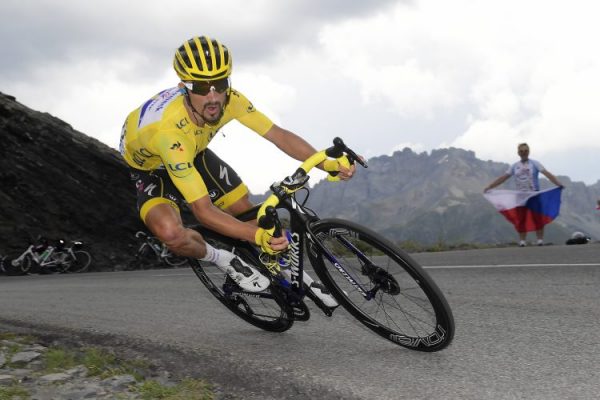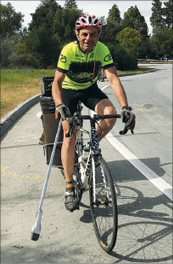By: Chris Carmichael
Descents are free speed. You spend almost every second of a bike ride pedaling and working to move forward, but the descents are your reward and your opportunity to make up time. For professional cyclists at the Tour de France, however, descents aren’t always free. Many times they are stressful and fraught with extreme risk. The Wall Street Journal did a nice job talking about the risks inherent in descending at high speed at the Tour de France, and in both the Pyrenees and Alps we’ve already seen several riders take extreme risks racing downhill.
Back on Stage 16 of the 2015 Tour, Peter Sagan worked his way into the day’s long breakaway and was still in contention on the final climb, the Col de Manse. The descent off that climb was the same one that ended Joseba Beloki’s career when his back wheel slipped in melted tar and he high-sided himself. He came back to the sport after his broken hip healed, but was never the same rider and retired shortly after. When Ruben Plaza attacked on the climb and gained nearly a minute over the group containing Sagan, everyone knew Sagan was going to use his well-known descending prowess in an all-out effort to catch Plaza and win the stage. The resulting display of bike handling and risk taking is breathtaking to watch, but Plaza’s effort on the climb proved to be too much for Sagan to overcome.

Then the descent comes
Following the rest day, descending was again a major factor in the results of Stage 17. This time it was the final descent before a short but tough finishing climb to Pra-Loup. The descent of the Col d’Allos is notoriously treacherous. The road surface is OK but not great, the road is characteristically narrow, and it features a lot of reducing-radius turns (when a turn gets tighter as you go through it). If this descent was in the beginning or middle of a stage riders would give each other some space and cruise down. But with a 6.2km climb to a summit finish starting right at the bottom of the descent, everyone in the breakaway group and the yellow jersey group was racing hard down the mountain.
France’s Thibaut Pinot was in the day’s long breakaway and though he was gapped on the climb up the Col d’Allos, a strong descent would have set him up with a very good chance of catching stage leader Simon Geschke on the final climb. But Thibaut Pinot is not a strong descender. In fact, he’s the rider who abandoned the Tour de France in 2013 over his fear of going downhill at race pace. Since then he’s worked hard to overcome his fear and become a competent descender, but it’s clear it’s not something he loves to do. Trying to race aggressively downhill he slid out in a switchback, and though he popped right back up and continued on, his mojo was clearly gone and he lost time for the rest of the descent.
It’s the basics
So, what makes the difference between a beautiful, fast, and smooth descent and a nervous, wobbly one? Courage accounts for a little of it, but skill is the foundation of great descending. Skill instills confidence and confidence builds courage, and the combination of skill, confidence, and courage gets you down the mountain fast.
If you’re not racing you don’t need to take big risks on descents, and it’s important to note that having great descending skills doesn’t mean you have to go insanely fast or take big risks. On the other hand, there is no downside to having the skills to be a great descender, because it will make you safer and more confident in all conditions.
Everyone has to slow down for the corners, but the best riders take great lines, position themselves over their bikes perfectly, brake late and slow down the least; and those skills can either move you off the front of the pack or help you catch back on. If you go back and watch the descents from stages in the Pyrenees and Alps, here are some skills to watch for – and emulate the next time you go downhill:
1. Think and look far ahead
Traveling at 62mph (Mark Cavendish reached 101kph on the descent of the Col du Tourmalet), you cover approximately the length of a football field (300 feet) every 3.3 seconds. With corners, rocks, potholes, etc. coming at you that quickly, you have to pick your lines early. Ideally you want to set up wide as you enter a corner, cut through the apex, and exit wide. Choosing the wrong line on the entry makes it difficult – and sometimes impossible – to safely exit the turn and stay on the road.
2. Brake late, but before the corners
You want to make dramatic changes in speed on the straightaway before you enter a corner, using both brakes so you are complete control of your speed. You may still be on the brakes in the turn, but if you were going 40mph in the previous straightaway, you want to bring the speed down to a safe speed for the corner – say 25-30mph – before the turn rather than trying to dramatically slow down and change direction at the same time.
If you go into a corner too hot and grab a fistful of brakes, you’ll either lock up the wheels and slide or crash; or your momentum will carry you so far to the outside of the turn that you’ll miss the exit and end up in the trees. The more advanced way to do this is to brake late; that is, hold your speed until you’re closer to the corner and use more braking power to slow down quickly. The trouble is, if you get it wrong you’ll end up like Roman Barguil on Stage 16 when he overshot a corner and shoulder-checked Geraint Thomas into a telephone pole.
3. Look through the corner
Your bike goes where your eyes are pointed, so look through to the exit of the corner. Don’t focus on the potholes or the guardrail at the edge of the road unless that’s where you want your wheels to go.
4. Plant your weight on your outside foot
To corner safely, you need your center of gravity to remain over your tires and your weight distributed appropriately across both wheels. With your body weight planted on the pedal facing the outside of the corner, you’re increasing the traction your tires have on the road. You can’t be tentative about this; press your weight onto the outside foot.
5. Lean your bike more than your body
This is relative. When you ride into a corner, both your body and bike lean to the inside of the turn, but you should lean the bike more than you lean your body. To do this, plant your weight on your outside leg and extend the arm facing the inside of the corner. As you extend your inside arm, you’ll notice the bike drops into the corner and your body weight feels like it is primarily directed through your outside leg and your inside arm. This is a very stable position and it provides a lot of traction; you just have to remember to be agile on the saddle so you can move and position the bike underneath you.
6. Prepare for reducing-radius turns
These are the tricky bends. The hardest part about a reducing-radius turn is that you often don’t know about it until you’re in it. At that point you have to be able to adjust your line through the turn because your original line will take you too wide. To tighten your line, focus more force on your inside arm to push it into the inside of the turn. With your weight pressed on your outside leg, pushing with the inside arm will cause the bike to lean more into the turn while keeping your center of mass near the wheels to maintain traction.



